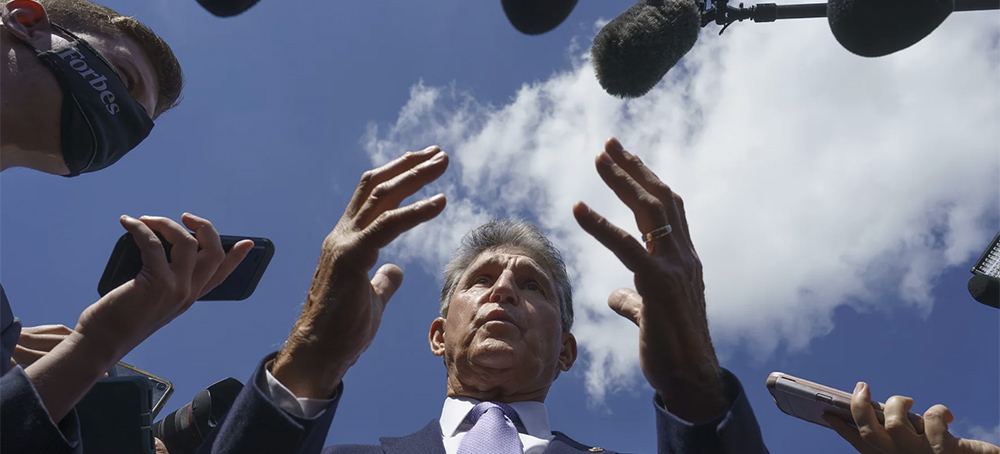Live on the homepage now!
Reader Supported News
ALSO SEE: From Charm Offensive to Scorched Earth:
How Biden's Fragile Alliance With Manchin Unraveled
ALSO SEE: Jonathan Chait | Did Manchin Just Kill
Biden's Domestic Agenda?
The White House accused Manchin of going back on his word.
“Senator Manchin’s comments this morning on Fox are at odds with his discussions this week with the president, with White House staff and with his own public utterances,” Jen Psaki, the press secretary, said in a statement.
Adding to angry accusations of betrayal from leading progressives including Senator Bernie Sanders, Psaki said: “Weeks ago, Senator Manchin committed to the president, at his home in Wilmington, to support the Build Back Better framework that the president then announced. Senator Manchin pledged repeatedly to negotiate on finalising that framework ‘in good faith’.
Citing work by Manchin on the proposed bill this week, Psaki said: “Senator Manchin promised to continue conversations in the days ahead, and to work with us to reach that common ground.
“If his comments on Fox and written statement indicate an end to that effort, they represent a sudden and inexplicable reversal in his position, and a breach of his commitments to the president and [his] colleagues in the House and Senate.”
Biden and Democrats said this week they would delay the bill until next year but the president vowed it would pass and said he would continue talking to Manchin.
But on Sunday Manchin used an interview with Fox News Sunday to announce his withdrawal from such talks – a hugely provocative move in a party in which he and Kyrsten Sinema of Arizona, another centrist, have held up Biden’s agenda to huge progressive frustration.
With the Senate split 50-50 and Republicans unanimously against, Manchin’s opposition means Build Back Better is all but dead in the water.
Citing the cost of the plan and economic worries including inflation, the national debt and the Omicron coronavirus variant, Manchin said: “I’ve always said this ... if I can’t go home and explain it to the people of West Virginia, I can’t vote for it.”
“I cannot vote to continue with this piece of legislation. I just can’t. I’ve tried everything humanly possible. I can’t get there.”
The host, Bret Baier, seemed surprised.
“You’re done?” he asked. “This is a no?”
Manchin said: “This is a no on this piece of legislation. I have tried everything I know to do.”
Manchin also issued a lengthy statement in which he cast the US debt as a spectre haunting all other concerns, domestic and foreign.
“For five and a half months,” he said, “I have worked as diligently as possible, meeting with President Biden, [Senate] majority leader [Chuck] Schumer, [House] Speaker [Nancy] Pelosi and my colleagues on every end of the political spectrum to determine the best path forward despite my serious reservations.
“I have made my concerns clear through public statements, op-eds and private conversations. My concerns have only increased as the pandemic surges, inflation rises and geopolitical uncertainty increases.
“… Despite my best efforts, I cannot explain the sweeping Build Back Better act in West Virginia and I cannot vote to move forward on this mammoth piece of legislation.”
Manchin cited a report by the non-partisan Congressional Budget Office which said that if the bill’s spending increases and tax cuts became permanent, $3tn would be added to its cost. Democrats criticised the report, which Republicans requested.
Psaki rejected each claim in Manchin’s statement, and said: “Just as Senator Manchin reversed his position on Build Back Better this morning, we will continue to press him to see if he will reverse his position yet again, to honor his prior commitments and be true to his word.”
On CNN’s State of the Union, Sanders listed Build Back Better provisions including investment to combat the climate crisis and improve health and social care.“I’ve been to West Virginia,” he said. “And it’s a great state, beautiful, but it is a state that is struggling.
“[Manchin] is going to have to tell the people of West Virginia why he’s rejecting what the scientists, the world is telling us, that we have to act boldly and transform our energy system to protect future generations from the devastation of climate change.
“… I hope that we will bring a strong bill to the floor of the Senate and that Joe Manchin should explain to the people of West Virginia why he doesn’t have the guts to stand up to the powerful special interests.
“… If he doesn’t have the courage to do the right thing for the working families of West Virginia in America, let him stand up and tell the whole world.”
Analysts would counter that Manchin is the only Democrat in major office in a state which voted solidly for Donald Trump, cuts his cloth accordingly and could easily switch allegiance, putting the Senate back in Republican hands.
In his statement, Manchin echoed Republican claims that Build Back Better is “socialist” in intent, saying: “My Democratic colleagues in Washington are determined to dramatically reshape our society.”
Sanders, a self-identified democratic socialist, promised to make Manchin’s stance an election issue, saying: “I think … that right up to the 2022 election [we ask]: ‘Which party is prepared to do the right thing for the elderly, for the children?’
“By the way, we talk about kids, I want everybody out there to know if Manchin votes no, those $300 tax credits that have gone a long way to reducing childhood poverty in America? They’re gone. That’s all. We cut childhood poverty by 40%, an extraordinary accomplishment. Manchin doesn’t want to do that.
“Tell that to the struggling families of West Virginia.”
In the 50-50 Senate, Manchin has gained huge power. He voted for coronavirus relief and a bipartisan infrastructure bill, big-ticket spending items. But he has opposed reform to the filibuster, the rule that requires a supermajority for most legislation, even in answer to Republican moves to restrict voting among Democrats.
The infrastructure bill was “decoupled” from Build Back Better to ensure passage through the Senate. Ayanna Pressley of Massachusetts, one of six House progressives who voted no on infrastructure despite assurances from Biden that he would get all senators on board for Build Back Better, refused to blame the president for Sunday’s disaster.
“My lack and deficit of trust was about Senator Manchin,” she told CNN. “He’s continued to move the goalposts. He has never negotiated in good faith, and he is obstructing the president’s agenda, 85% of which is still left on the table. And in obstructing the president’s agenda, he is obstructing the people’s agenda.”
Pressley was asked if Build Back Better might be split into smaller bills, to attract moderate Republicans.
She said: “I remain focused on keeping the pressure on Senator Manchin, the White House using the full weight of this presidency to lean on this senator to show solidarity with this Democratic party and with the American people and to stop obstructing the president’s agenda, which is the people’s agenda.
“This is a mammoth bill to address. Let’s get it done.”
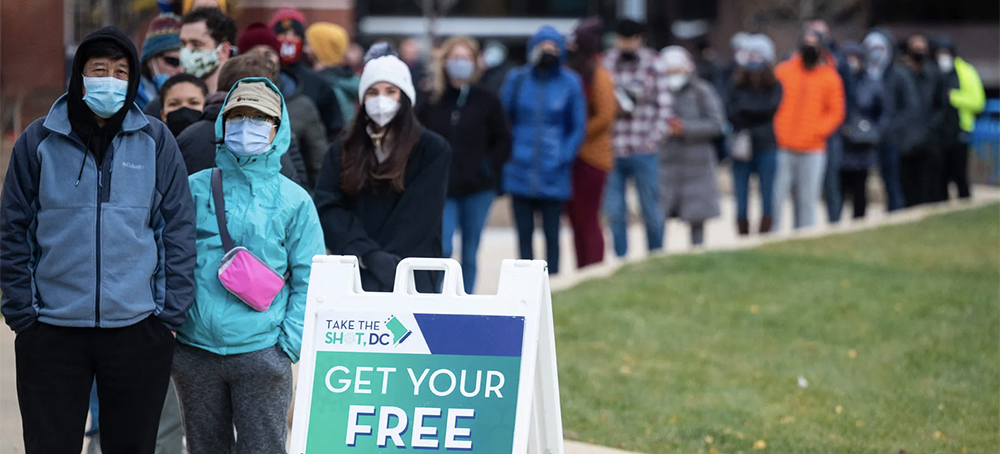 Health officials recommend getting a booster dose of COVID-19 vaccine to shore up protection against the omicron variant. (photo: Jim Watson/AFP/Getty Images)
Health officials recommend getting a booster dose of COVID-19 vaccine to shore up protection against the omicron variant. (photo: Jim Watson/AFP/Getty Images)
The worst-case scenario with the new variant could be 20 percent more US Covid-19 deaths than last winter.
Already, countries like South Africa, the United Kingdom, and Denmark have seen sharp spikes in new Covid-19 cases, with some areas reaching record highs. South Africa has reported far fewer hospitalizations from omicron compared to previous waves, but the UK is is in the midst of a sharp rise in hospitalizations, about 30 percent higher week over week.
The big reason is that omicron appears to spread far more readily than the delta variant that has been dominant worldwide since the summer — omicron is 25 to 50 percent more transmissible, according to some UK estimates.
The current moment is an eerie echo of December 2020, when the first major variant of Covid-19 began infecting people around the world. But a key difference now is that there are effective vaccines that have been widely deployed in some countries. In the US, more than 70 percent of the population have had at least one dose of a vaccine and 30 percent of those vaccinated have received two doses and a booster, which should absorb some of the impact of omicron.
Yet epidemiologists and health officials are sounding the alarm about another tsunami of infections — in hopes people will take more precautions, and to help hospitals and health workers prepare to care for the sickest patients. “Omicron could be just as deadly as delta even if it causes milder disease,” Celine Gounder, an infectious disease specialist who has advised the White House, told reporters this week. Considering the potential impact on the health care system is also crucial as decision-makers weigh another round of restrictions — closing schools, banning large gatherings, reimposing mask mandates.
In one of the most comprehensive forecasts to date, researchers from the Covid-19 Modeling Consortium at the University of Texas at Austin on Friday chalked out 18 different scenarios for omicron. Their study was not peer-reviewed, but the findings show that the US is facing yet another dangerous variant while the conditions for spreading it — the holiday season — are at their most favorable.
The most optimistic pathway in the study would lead to more than 50 percent fewer deaths compared to last year — the six-month period spanning December 1, 2020, to May 1, 2021 — while the most pessimistic route would end with 20 percent more fatalities than that grim period last winter and spring.
“Everything we’ve seen so far — growth in Denmark, growth we’re seeing in the United States, in Canada, in the UK — suggests that these scenarios are actually very plausible ... for our country,” said Spencer Fox, associate director of the UT Covid-19 Modeling Consortium.
A lot depends on the mutated virus itself, particularly how badly it sickens unvaccinated (and vaccinated) people. While some early reports have hinted that omicron causes a lower rate of severe Covid-19 illness compared to prior variants, there’s still not enough data to be sure. “It’s too uncertain right now to say that,” Fox said. (The UT model currently assumes that omicron’s severity is the same as with delta in unvaccinated people with no prior infection, and that protection against severe illness from prior infection and vaccines may be similar or reduced.)
Getting a booster dose of a Covid-19 vaccine is the most effective action an already-vaccinated individual can take to protect against the variant, and if enough people get an extra shot, thousands of deaths could be averted this winter, according to the models.
However, communities around the US have so far responded in drastically different ways to the Covid-19 pandemic — some imposing policies that have slowed transmission, and others rejecting those policies and suffering terrible consequences in the form of overwhelmed hospitals and thousands of preventable deaths. So it’s likely that both the best and worst scenarios could play out in parallel over the coming months, in different places.
Omicron is set to become the dominant Covid-19 variant in the US
As people head indoors to warm up from the cold and celebrate the winter holidays, omicron will find ample opportunities to jump from lung to lung. In addition to its greater transmissibility, early results also show omicron can better evade the shielding provided by the immune system that’s built up from vaccines or from prior infections. One recent study suggests that antibodies produced to counter past versions of the virus are far less effective at curbing omicron, which could make the variant more likely to cause a breakthrough infection or reinfection.
At the same time, the delta variant of SARS-CoV-2 is continuing to wreak havoc, having recently pushed the US death toll above 800,000. Flu could come roaring back this winter, as well, generating a fresh wave of hospitalizations among the most vulnerable to that infection, too. The combined threats of all these respiratory illnesses could push some hospitals to horrific new levels of overcapacity — especially those already stretched thin from staffing shortages and other strains after two years of crisis.
Specifically, experts worry that hospitals will have to ration care or turn patients who need life-saving care away — something many hospitals had to do in earlier Covid-19 surges — if a a lot of new severely ill patients come flooding through the doors.
“Besides the toll of suffering and death which will inevitably go up if, in fact, we have that convergence in the winter months of flu and omicron and delta, we could get our hospital systems overwhelmed,” Anthony Fauci, the director of the National Institutes of Allergy and Infectious Disease, said Thursday.
But how bad, exactly, could it get?
Fox and his colleagues modeled Covid-19 cases, hospitalizations, and deaths through the winter and into May 2022. For their 18 scenarios, they tweaked factors like the transmissibility of omicron, differing degrees of severity of the virus, the level of immunity in the US population, the likelihood of reinfection among Covid-19 survivors and breakthrough infections among those vaccinated, and the number of people who topped up their vaccine doses with a booster.
Under all the scenarios they modeled, omicron supplanted delta and became the main driver of Covid-19 infections, pushing case counts higher. “The first key finding is that unless significant transmission reduction happens in our communities, we’re likely to see an omicron surge that rivals the previous peak that we saw in January 2021,” Fox said.
The most optimistic scenario emerged in the researchers’ model when omicron was 50 percent more transmissible than delta and 10 percent better at eluding immunity from vaccines and previous infections, yet led to equally severe illnesses. That scenario also presumed many people will get boosters — at 80 percent uptake by March 2022 — but that no other policy or behavior changes are made to reduce transmission. It predicted a Covid-19 peak in mid-January 2022, but with 8 percent fewer cases and 43 percent fewer hospitalizations than the same six-month period the year before. It also led to 54 percent fewer deaths, totaling 152,000 (still a grim result).
The worst outcome arose when the model assumed omicron was just as transmissible as delta, but far more evasive of prior immunity and much more likely to cause severe disease. In this scenario, prior immunity was 85 percent less effective at preventing infection from omicron, and protection against death was 22 percent lower. In this worst case, vaccine booster uptake remained fairly low, reaching only 57 percent by the end of March 2022. This resulted in Covid-19 cases peaking in early February 2022 and 342,000 deaths over six months, a 20 percent increase from 2021.
That Covid-19’s devastation could be even worse in an era of vaccines and treatments is tragic, a stark consequence of failing to get the pandemic under control across the country.
However, if the booster uptake rate increased to 80 percent, Covid-19 cases in this scenario dropped by 5 percent, hospitalizations by 12 percent, and deaths by 13 percent. That translates to 1.3 million averted infections and 39,000 lives saved between December 2021 and May 2022.
The scenarios show that there is a bit of luck involved in how harsh the next few months will be, but specific actions like getting booster doses of vaccines rolled out can vastly improve the outlook.
The US is not united when it comes to Covid-19
For millions of Americans, now two years into the pandemic, omicron is triggering an exasperating episode of déjà vu.
However, the question of the variant’s severity is still unclear. And researchers warn that even if omicron turns out to be less dangerous for individuals, it could still cause widespread damage if it continues to spread out of control.
The context for the omicron surge also varies throughout the country, something not accounted for in the UT Austin simulation. “This analysis is really just looking at an average across the whole country,” said Fox.
There are things it doesn’t factor in: the rate of preexisting health conditions, access to health care, exposure to prior waves of infection, adherence to mask-wearing, and vaccine uptake — which can be radically different around the country. Around 72 percent of the US population have received at least one shot of a Covid-19 vaccine, but in states like Idaho and Mississippi, only half have gotten it. New Hampshire, meanwhile, is above 90 percent. There are around 90 million people who are unvaccinated against Covid-19 throughout the country, but many are concentrated in distinct regions, often aligned with political views.
That means omicron could play out quite differently in different parts of the country, with some places facing far more hospitalizations and deaths than others with high vaccination rates. And given how readily omicron can spread, the regions with lower vaccination rates that have so far lucked out of previous waves may now be vulnerable.
This is definitely not the time to let our guard down
People who have not been previously infected or immunized against Covid-19 face the greatest risk of omicron infection. But omicron has also shown that vaccinations are not an impermeable shield against infection.
Many omicron cases have been detected in people who completed their course of Covid-19 vaccines, even in some people who received booster doses. It’s a disheartening prospect for people who have rigorously followed public health advice throughout the pandemic, eager for it to be over.
“I share the frustration,” said Justin Feldman, a research fellow and social epidemiologist at Harvard University. “Unfortunately, I don’t think that [the coming omicron wave is] something that individuals can solve with their own personal behaviors.”
The most impactful measures for dealing with Covid-19 have to happen at the policy level, according to Feldman. That includes easily accessible widespread testing for Covid-19 to detect infections early so people can isolate from others and seek treatment, something the US is still struggling to do. It also includes mandates for vaccines, quarantine and isolation rules for workers, regulations for indoor ventilation, making high-quality masks widely available, and training a corps of pandemic responders to administer tests, treatments, and vaccines.
“These are things Biden should have been trying to build since January 20, but largely hasn’t because the administration went with a very vaccine-centric approach,” Feldman said.
While the White House has taken some steps to implement some of these policies, like purchasing and distributing millions of rapid Covid-19 tests, it’s becoming clear there is little political will to implement more restrictions even as another towering wave of Covid-19 infections crests. Mask mandates are lapsing, travel is increasing, businesses are reopening, and large indoor gatherings are resuming.
“But that doesn’t mean apathy is the solution,” wrote Vox’s Dylan Scott.
The pandemic playbook of maintaining social distancing, rigorous hand-washing, wearing face coverings, getting tested for Covid-19 after a possible exposure, and getting vaccinated remains useful, even if it doesn’t completely solve the problem.
With omicron, there are some tweaks to this; namely, for eligible vaccinated people to get boosters, and for people to ditch cloth face masks for higher-quality options like N95 respirators and KN95 masks.
“We are really recommending that people up their mask game, especially now with omicron,” Gounder said.
Regardless of what course omicron takes throughout the country, health officials are bracing for a situation that will get far worse before it gets better. “I think we really do need to anticipate there probably will be a surge and increase in hospitalizations over the coming months,” Gounder said. Just how dangerous it will be is partly in our hands.
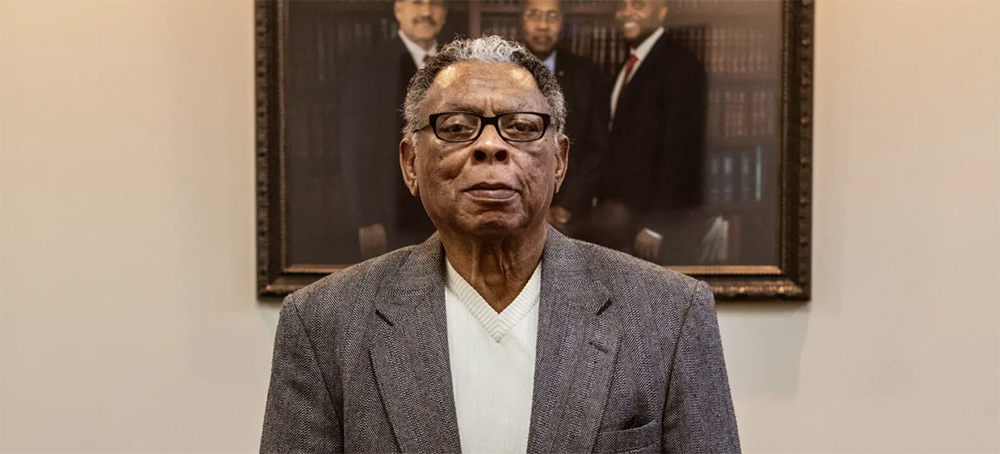 Robert Reives Sr. was elected three decades ago as the first Black commissioner in his North Carolina county. Republicans have redrawn the district lines, and he now fears he will lose his seat. (photo: Jeremy M. Lange/NYT)
Robert Reives Sr. was elected three decades ago as the first Black commissioner in his North Carolina county. Republicans have redrawn the district lines, and he now fears he will lose his seat. (photo: Jeremy M. Lange/NYT)
Black elected officials in several states, from Congress down to the counties, have been drawn out of their districts this year or face headwinds to hold onto their seats.
The county commission refused, and Mr. Reives prepared to sue. But after the county settled and redrew its districts, he was elected in 1990 as Lee County’s first Black commissioner, a post he has held comfortably ever since.
Until this year.
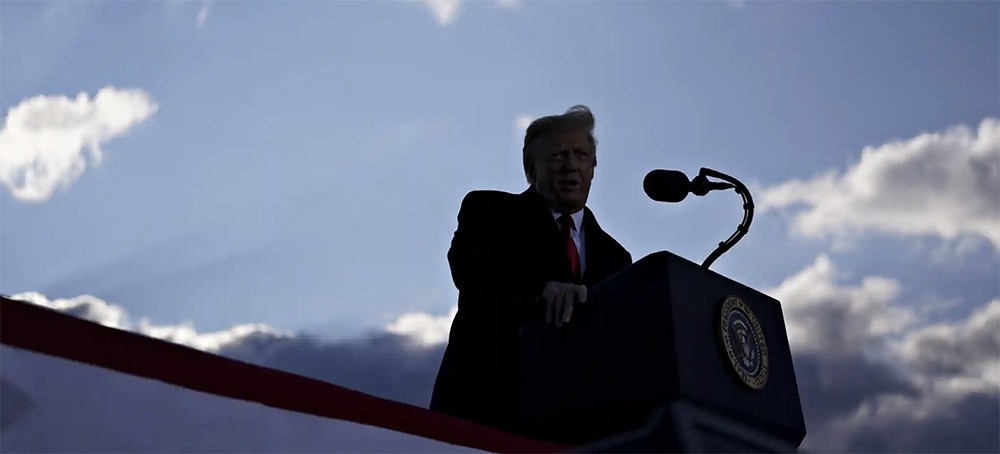 Donald Trump speaks during a farewell ceremony at Joint Base Andrews, Maryland, on 20 January this year. (photo: Rex/Shutterstock)
Donald Trump speaks during a farewell ceremony at Joint Base Andrews, Maryland, on 20 January this year. (photo: Rex/Shutterstock)
Flurry of recent revelations raises the specter that the committee is swiftly heading towards an incriminating conclusion
The former president in recent weeks has complained more about the investigation, demanding why his former White House chief of staff, Mark Meadows, shared so much material about 6 January with the select committee, and why dozens of other aides have also cooperated.
Trump has also been perturbed by aides invoking the Fifth Amendment in depositions - it makes them look weak and complicit in a crime, he has told associates - and considers them foolish for not following the lead of his former strategist Steve Bannon in simply ignoring the subpoenas.
When Trump sees new developments in the Capitol attack investigation on television, he has started swearing about the negative coverage and bemoaned that the House minority leader, Kevin McCarthy, was too incompetent to put Republicans on the committee to defend him.
The former president’s anger largely mirrors the kind of expletives he once directed at the Russia inquiry and the special counsel investigation when he occupied the White House. But the rapidly accelerating investigation into whether Trump and top aides unlawfully conspired to stop the certification of Joe Biden’s victory at the 6 January joint session appears to be unnerving him deeply.
The portrait that emerges from interviews with multiple sources close to Trump, including current and former aides, suggest a former president unmoored and backed into a corner by the rapid escalation in intensity of the committee’s investigation.
A spokesperson for Trump did not respond to requests for comment.
But as Trump struggles to shield himself from the select committee, with public hearings next year and the justice department said to be tracking the investigation, the path ahead is only likely to be more treacherous.
The former president is especially attuned to his potential for legal exposure, even as he maintains he did nothing wrong in conferring about ways to overturn the 2020 election and encouraging supporters to march on the Capitol. He has expressed alarm to associates about repeated defeats in court as he seeks to stop the select committee obtaining some of the most sensitive of White House documents about 6 January from the National Archives, on grounds of executive privilege.
The reality is that with each passing day, the committee seems to be gathering new evidence about Trump’s culpability around the Capitol attack that might culminate with recommendations for new election laws – but also for prosecutions.
“I think that the justice department will keep a keen eye on what evidence the committee has accumulated, as well as looking out for witnesses for a potential case,” said Ryan Goodman, a former special counsel at the Department of Defense now a law professor at New York University.
“One of the outcomes of the committee’s work and the public hearings will be to demonstrate individuals who might be wanting to come forward as witnesses and that’s got to be very important to justice department prosecutors,” Goodman said.
House investigators are expected to soon surpass more than 300 interviews with Trump administration officials and Trump political operatives as part of a process that has yielded 30,000 documents and 250 tips via the select committee’s tip line.
The flurry of recent revelations – such as the disclosure of Meadows’s connection to a powerpoint outlining how Trump could stage a coup, as first reported by the Guardian – raises the specter that the select committee is swiftly heading towards an incriminating conclusion.
Trump’s associates insist they are not worried, at least for the moment, since the select committee has yet to obtain materials covered by executive privilege either through Meadows or the National Archives that could ensnare Trump personally.
The former president’s defenders are correct in that respect – the committee does not have messages that show Trump directing an attack on the Capitol, one source said – and Trump has vowed to appeal the National Archives case to the supreme court.
But no one outside the select committee, which is quietly making progress from a glass office on Capitol Hill with boarded-up windows and electronically secured doors, knows exactly what it has uncovered and whether the inquiry ends with a criminal referral.
The material Meadows turned over alone depicts an alarming strategy to stop Biden’s certification on 6 January, involving nearly the entire federal government and lieutenants operating from the Willard hotel in Washington.
One member on the select committee described the events around 6 January as showing a coalescence of multiple strategies: “There was a DoJ strategy, a state legislative strategy, a state election official strategy, the vice-president strategy. And there was the insurrection strategy.”
The text messages Meadows received on his personal phone implicate Trump’s eldest son, Don Jr, and Republican members of Congress. Texts Meadows turned over to the committee might also be used by an enterprising prosecutor as evidence of criminal obstruction to stop a congressional proceeding if the White House knew election fraud claims to be lies but still used them to stop Biden’s certification.
While Meadows never testified about the communications, a cadre of top Trump officials, from former acting national security adviser Keith Kellogg to Pence’s former chief of staff Marc Short, have moved to cooperate with House investigators.
The trouble for Trump – and part of the source of his frustration, the sources said – is his inability, out of office, to wield the far-reaching power of the executive branch to affect the course of the inquiry.
The limited success of strategies he hoped would stymie the committee – ordering aides to defy subpoenas or launching legal challenges to slow-walk the release White House records – has been jarring for Trump.
“I think what he’s finding is that as the ex-president, he has a lot less authority than he did as president. But his playbook doesn’t work if he’s not president,” said Daniel Goldman, former lead counsel in the first House impeachment inquiry into Trump.
In a reflection of dwindling legal avenues available to undercut the investigation, Trump has returned to launching attacks-by-emailed-statement on the select committee, stewing over his predicament and what he considers an investigation designed only to hurt him politically.
“The Unselect Committee itself is Rigged, stacked with Never Trumpers, Republican enemies, and two disgraced RINOs, Cheney and Kinzinger, who couldn’t get elected ‘dog catcher’ in their districts,” Trump vented last month.
In private, Trump is said to have reserved the brunt of his scorn for Meadows, furious with his former White House chief of staff for sharing sensitive communications on top of all the unflattering details about Trump included in his book this month.
Trump’s associates, however, have focused more on questioning the legitimacy of the select committee and its composition, arguing the fact that the House Speaker, Nancy Pelosi, appointed both Republican members reduces the investigation to a partisan political endeavor.
They also argue that none of the revelations to date – like the Guardian’s reporting on Trump’s call to the Willard hotel, during which he pressed operatives to stop Biden’s certification from taking place entirely – amounts to criminal wrongdoing.
But in the meantime, Trump is left with little choice but to wait for the committee’s report.
“The justice department seems to be more reactive than proactive,” Goodman said. “They might be waiting for the committee to wrap up its work to make criminal referrals.”
 Rep. Thomas Massie (R-Ky.) in a Christmas photo of his family he posted to Twitter on Dec. 4. (photo: @repthomasmassie/Reuters)
Rep. Thomas Massie (R-Ky.) in a Christmas photo of his family he posted to Twitter on Dec. 4. (photo: @repthomasmassie/Reuters)
Muscular Christianity — with scriptural interpretations that can favor ‘stand your ground’ over ‘turn the other cheek’ — has a long tradition in the United States
Others, however, saw in the photos something worth emulating. A week into the controversy, the Republican mayor of Maury County, Tenn., Andy Ogles, posted his own fortified family portrait to Facebook, commenting with a line often (dubiously) credited to George Washington: “The very atmosphere of firearms anywhere and everywhere restrains evil interference — they deserve a place of honor with all that’s good.”
No matter their intended effect, the photos represent a tradition far older than our current penchant for political trolling — one that, like it or not, is part of widely held interpretations of the upcoming holiday and the beliefs of many who observe it. That is the tradition of Muscular Christianity.
At the heart of both the outrage and the delight inspired by these Yuletide pictures was not just a surprising display of firepower but a common aspect of American religion that is unsettling to outsiders. These photos represent a shift in attitudes among some evangelical Christians that may have broader implications, as the previously subtle influences of firearms on faith become impossible to ignore.
The photographs themselves draw on a trend that stretches back at least a decade. Nevada politician Michele Fiore shared a similar image in 2015, and even then it was hardly an outlier. Starting in 2010, the Scottsdale Gun Club in Arizona invited patrons “looking for a fun and safe way to express their holiday spirit and passion for firearms” to pose for holiday photos with an arsenal that included pistols, AK-47s and grenade launchers. The “Santa and Machine Guns” event drew crowds and national media attention, resulting in hundreds of Christmas-card-ready tableaux that caused a stir when they appeared online.
In the years since, the marketplace has become crowded with products suggesting that guns are, for many, at least part of the reason for the season. Amazon and Etsy offer hundreds of ornaments and decorations in the shape of revolvers, rifles, bullets and shell casings, as well as camouflage “tactical stockings” for Second Amendment enthusiasts to hang by the chimney with care. (Amazon founder Jeff Bezos owns The Washington Post.)
Like most such merchandise, the Scottsdale photo promotion was decidedly nonreligious, but some condemned it in theological terms even so. “To involve machine guns and Santa in a celebration in the birth of Jesus Christ is the worst kind of heresy I can imagine,” Democratic state Rep. Steve Farley told the Associated Press in 2011. “I would suggest that the people who created this read some of the New Testament.”
Looking for biblical contradictions in these activities is missing the point, though. Religious traditions have never been limited to what texts say but rather are continually transformed by what people do.
For more than a century, American Protestantism has been shaped by the movement known as Muscular Christianity, which arose to combat expressions of the faith that critics of the time claimed had become bookish, soft, sedentary and — as they judged it then — excessively feminine. Popular publications such as 1912’s “The Masculine Power of Christ; or, Christ Measured as a Man” argued that Jesus was “distinctly manly and virile,” and it was the task of the Christian to be so as well.
Muscular Christianity, born in England in the mid-19th century, had humble origins that seem far removed from the excesses of American gun culture. Its most notable expression early on was the Young Men’s Christian Association, more commonly known as the YMCA, which by the 1850s was a global youth movement combining social ministries with wholesome recreation.
“We believe in muscular Christianity,” one advocate of this form of the faith said in 1860. “We believe that the minister of muscle will fight a more valiant and stronger battle with the passions and prejudices of men … and that saints’ bodies as well as sinners’ are none the worse for an hour at the dumb bells or weights.”
A somewhat more macho approach found particularly fertile ground in the expanding United States, where it meshed with myths of the frontier yielding to self-reliance and Manifest Destiny. Theodore Roosevelt was among its most prominent proponents. In 1903, the year he took a tour of 25 Western states, he declared, “I do not want to see Christianity professed only by weaklings; I want to see it a moving spirit among men of strength.”
As it traveled, Muscular Christianity broadened to include not only the kind of fitness fostered by the YMCA but even greater displays of force. Legends of pistol-packing preachers who trekked through the West with, as one of them said, “Bible in pocket, gun in hand” permanently joined evangelism to the six-shooter in some corners of the American imagination.
From time to time this metaphoric connection has been taken literally. Since the 1970s, the spread of “Cowboy Churches” has taken an approach to worship that began at rodeos and made it available across the country to evangelicals who have never sat atop a horse but are drawn to a Marlboro Man aesthetic. As with guns on Christmas cards, the line between sincerity and performance in such spaces is not always obvious, though it is often clear that their interpretations of scripture favor “stand your ground” over “turn the other cheek.” Their facilities often include shooting ranges along with room to rope and ride.
As the scholar Kristin Du Mez chronicles in her recent book, “Jesus and John Wayne,” the overlap of places to worship and places to shoot is no accident. “Writers on evangelical masculinity have long celebrated the role guns play in forging Christian manhood,” Du Mez writes. “From toy guns in childhood to real firearms gifted in initiation ceremonies, guns are seen to cultivate authentic, God-given masculinity.”
More than 40 percent of White evangelicals own firearms, far outpacing other religious groups and the general population, according to a Pew Research Center study. In a sense, American evangelical culture is a significant part of American gun culture, and vice versa. Neither would be the same without the other. Their entwined influence can be seen in scriptural arguments for bringing firearms to church, as well as on hoodies extolling the trinity of “God, Guns and Trump” worn at the assault on the U.S. Capitol on Jan. 6.
All of this might seem far removed from holiday cards, until one recalls that it is Jesus himself who has been proposed as the exemplar of the “manly and virile” faith found at the root of Christmas trees festooned with ammunition.
Long implicit in evangelical understandings of scripture and tradition, the connection between God and guns has lately been finding more visible expression. On Dec. 25, Christians around the world will remember the birth of an infant often called the Prince of Peace. Some will also celebrate a man they’re certain would know how to handle an AR-15, and in this they see no contradiction.
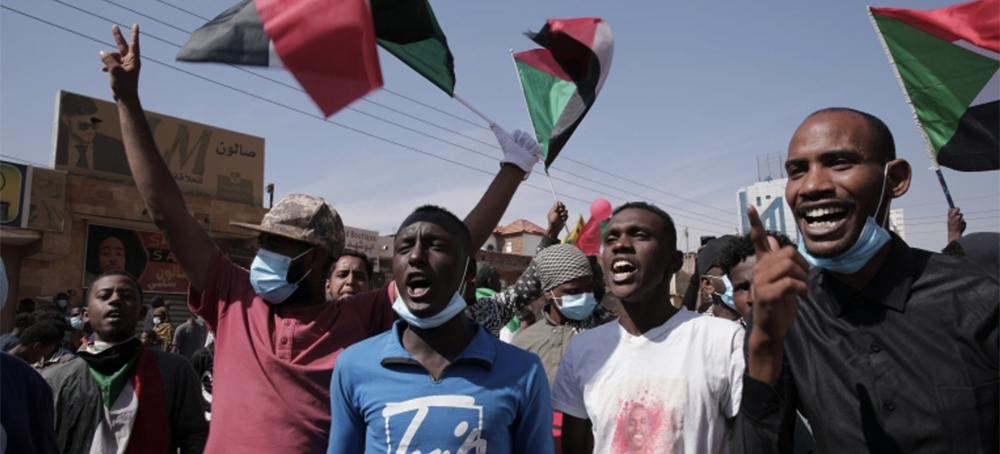 People take part in a protest against the October military takeover in Khartoum, Sudan. (photo: Marwan Ali/AP)
People take part in a protest against the October military takeover in Khartoum, Sudan. (photo: Marwan Ali/AP)
Demonstrators march to the presidential palace in capital Khartoum, protesting the military’s takeover of the country.
The outpouring of protests on Sunday is the latest in a series of demonstrations that have continued even after the reinstatement of the prime minister.
Demonstrations were also under way in other cities across the country to mark the third anniversary of protests that touched off a popular uprising that led to the overthrow of longtime President Omar al-Bashir.
On Saturday night, Prime Minister Abdallah Hamdok warned in a statement that Sudan’s revolution faced a major setback and that political intransigence from all sides threatened the country’s unity and stability.
Ahead of the protests, security forces sealed off major roads leading to the airport and army headquarters as well as most bridges connecting Khartoum to sister cities Bahri and Omdurman across the Nile River.
Al Jazeera’s Hiba Morgan reporting from Khartoum said that for a few minutes, protesters were able to reach the southern gates of the presidential palace, but were met with tear gas and live ammunition.
“A majority of them have been forced to retreat following a heavy amount of tear gas that has been fired by security forces,” Morgan said.
“The military who guard the presidential palace have also used live ammunition, according to protesters who ran away from the southern gates of the presidential palace.”
But protesters are still gathering on the road leading to the palace, Morgan said.
“Many of them are not far from the front gate.
“They say they’re here to voice their demands and show the military that they want a civilian rule and no amount of tear gas or live ammunition will take them away from their demands.”
Protesters chanted “the people are stronger and retreat is impossible”, with some darting into side streets to dodge volleys of tear gas.
Despite security forces blocking bridges into the capital, protesters were able to cross a bridge connecting the city of Omdurman to central Khartoum but were met with heavy tear gas, Reuters witnesses said.
Al Jazeera’s Mohamed Vall reporting from Khartoum said it’s an “interesting situation as the police barricaded the entire centre of Khartoum this morning”.
“There was this sense during the day that the protesters would not be allowed to reach the presidential palace; there was heavy use of tear gas and sound bombs. We have seen crowds being dispersed everywhere,” Vall said.
“But a huge number of protesters were able to cross the bridge between Khartoum Bahri and central Khartoum where the presidential palace is, without major hindrance.”
Images shared on social media showed protests beginning in cities outside Khartoum, including Port Sudan on the Red Sea coast and El-Deain in the western region of Darfur.
It would be the ninth in a series of demonstrations against the coup that have continued even after the military reinstated Hamdok, who had been under house arrest, on November 21 and released him and other high-profile political detainees.
The Central Committee of Sudanese Doctors says 45 people have been killed in crackdowns on protesters since the coup.
The military and civilian political parties had previously shared power since al-Bashir’s removal. But the deal reinstating Hamdok faces opposition from protesters who had seen him as a symbol of resistance to military rule and denounced it as a betrayal.
“The protesters are saying the revolution is incomplete because the military is still in power,” Morgan said.
“They are saying the military should go back to the barracks and that power should be handed to a civilian government. Many of them are saying they are not satisfied with the way the revolution has been going on over the past two years.”
Civilian parties, and neighbourhood resistance committees that have organised several mass protests, demanding full civilian rule under the slogan “no negotiation, no partnership, no legitimacy”.
On Saturday night and early Sunday morning, people arrived in bus convoys from other states, including North Kordofan and Gezira, to join protests in Khartoum, witnesses said.
A rally on Friday by members of civilian parties, known as the Forces of Freedom and Change coalition, was broken up by tear gas from an unclear source as witnesses told Reuters there was no sign of security forces on the scene.
 In this aerial view, the bodies of six giraffes lie on the outskirts of Eyrib village in Sabuli Wildlife Conservancy on December 10, 2021 in Wajir County, Kenya. (photo: Ed Ram/Getty Images)
In this aerial view, the bodies of six giraffes lie on the outskirts of Eyrib village in Sabuli Wildlife Conservancy on December 10, 2021 in Wajir County, Kenya. (photo: Ed Ram/Getty Images)
The images show six dead giraffes, their emaciated bodies intertwined, at the Sabuli Wildlife Conservancy in Northeastern Kenya. They died due to malnutrition caused by a lack of vegetative growth and water due to the drought.
According to the photographer, photojournalist Ed Ram, the giraffes were trying to reach a nearby reservoir desperate for water — but it had dried up.
The Star, a Kenyan news publication, reports that the lives of over 4000 giraffes in the region are now at risk.
The current drought began in December 2020, Al Jazeera reported. The UN reports that some parts of Kenya have not seen such poor rainfall since 1981.
According to the analysis written by the UN Office for the Coordination of Humanitarian Affairs, the crop reduction and water insecurity have left almost 2.4 million people in Kenya unable to access food every day. As a result, 368,000 people face "emergency levels of hunger," as well as 523,000 children under age five in urgent need of treatment for acute malnutrition.
Speaking to Al Jazeera, Zenab Kule, a 25-year-old pregnant Kenyan woman has been forced to feed herself and her toddlers with just maize, as no other crops are available. The family is exhibiting frequent symptoms of malnourishment and dehydration.
"The only hope I have left is for the rain to come," she said.
Follow us on facebook and twitter!
PO Box 2043 / Citrus Heights, CA 95611

